
|
Sale 38
Manuscript and Collectibles Auction
| Lot |
Photo |
Description |
Realized |
Lot 1232 |
 |
Two Hand Axes From the Homo Heidelbergensis Culture. These two hand axes are from the Achelean and are between 150,000 to 300,000 years old. The larger 6x4" hand axe has classic shape and possesses the lovely brown patina that is found on the best quality hand axes from the Western Sahara Desert. The lustrous brown color is known as desert varnish; it occurs when the top side of the hand axe is sand blasted over thousands of years. The second 5½x3" hand axe is very unusual in that it is composed of two different kinds of rock. Most of the hand axe is composed of a light tan colored rock but there are two veins of hard dark brown rock near the bottom with one piece forming a smooth base that feels very comfortable in one's hand when used as a tool and the tip has been somewhat worn down through use. Homo heidelbergenis was an archaic Home species that may have been one of our direct ancestors. Add $20 for domestic shippping.
Estimated Value $300 - 500.
View details and enlarged photo
| Unsold |
Lot 1233 |
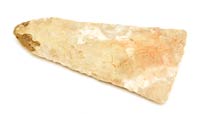 |
Well Formed Triangular Ax Blade in Chert. Egypt, Neolithic, c. 6000-4000 BC. Blade roughly triangular in cross section, the knapping regular and neat. The stone predominantly buff color, with brown and creme mottlings. Some "desert varnish" noted. Intact and well preserved. Length: 6-5/8".
Estimated Value $300 - 400.
View details and enlarged photo
| Unsold |
Lot 1234 |
 |
Lug-handled Jar with Painted Spirals and Wavy Lines. Egypt, Naqada II, c. 3500-3100 BC. Jar with broad ovoid bowl, lug handles with narrow bores, flat everted rim. Painted spirals of varying size arranged into two rows encircling vessel. Handles and other areas with wavy lines; crisscross lines at rim. Small restorations to two chips on the rim, otherwise vessel intact and in very fine condition; the paint bold. Width: 7-1/4". A larger and excellent example of this popular early artifact.
Estimated Value $3,000 - 3,500.
Cf. Scott, Yale, 8b; and especially Sotheby's NY, December 8, 1995, lot 9 ($4000-$6000).
View details and enlarged photo
| Realized
$4,025 |
Lot 1235 |
 |
Lug-handled Jar with Painted Ornament. Egypt, Naqada II-III, c. 3500-3100 BC. Jar with wider ovoid bowl, lug handles with narrow bores, and flat everted rim. The whole vessel covered with rows of scale-like patterning. Discreet, nearly invisible repairs have been made to the body. Width: 7-1/2". An interesting variant to the usual examples. Again, a particularly large example.
Estimated Value $2,500 - 3,000.
View details and enlarged photo
| Unsold |
Lot 1236 |
 |
A Pair of Very Early Faience Tiles. Egypt, 3rd Dynast, Reign of King Djoser, c. 2690-2660 BC. The tiles rectangular, with slightly convex faces; the backs with flat "loops," pierced for stringing.The color of the faience now a soft robbin blue, with one tile greener. Of note is that each bears what appears to be a single hieroglyph incised on the back. Pieces with slight edge nicks, or small chips to the "loops." Otherwise intact and in very good condition. Size: 2-1/4" x 1-3/8". These are ideal artifacts for those who cherish early writing, especially that which can be coupled with key figures of history! Lot of 2 items.
Estimated Value $800 - 900.
Djoser ranks high in Egyptian history for successfully building, under the guidance of his vizier/architect, Imhotep, the first large-scale pyramid. Among the decoration of its interior chambers, rows of blue faience tiles were arranged among raised bands of limestone, to simulate the reed-mat structure of the earliest Egyptian buildings. Cf. Friedman, Gifts of the Nile, pp. 72-73, 180-181, where back views also show single incised glyphs, but different from these here.
View details and enlarged photo
| Realized
$870 |
Lot 1237 |
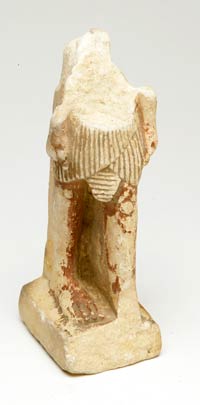 |
Polychromed Fragment of Striding Man, in Limestone. Egypt, New Kingdom, c. 1500-1100 BC. The man stands in classic pose, with one foot forward, and closed hands at sides. Carefully carved, he wears a pleated kilt, arranged into three sections. Considerable dark red paint remains on flesh areas, with traces of yellow behind one foot. The back pillar with well engraved inscription, which also shows hints of red paint. Condition as seen in photo, with both hands intact, and the inscription fine and sharp. Height: 6-1/8".
Estimated Value $2,000 - 2,500.
View details and enlarged photo
| Unsold |
Lot 1238 |
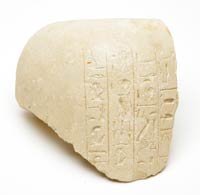 |
Inscribed Fragment from an Unusually Large and Heavy Funerary Jar. Egypt, New Kingdom, c. 1550-1085 BC. The shoulder fragment of a very thick and robust jar, carved in limestone. Visible are four vertical registers of hieroglyphic inscription, with traces of blue paint still within the engravings. This jar might have been one of the canopic receptacles for the organs of the deceased, or it could have been an adjunct vessel for the leftovers that didn't fit into those jars. Piece overall in very good to very fine condition. Size: 6" x 6-1/4". A large and always popular display of Egyptian writing.
Estimated Value $2,000 - 2,500.
View details and enlarged photo
| Unsold |
Lot 1239 |
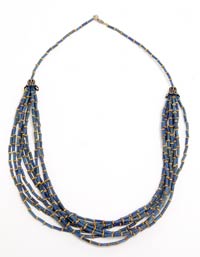 |
"Mummy Necklace" in Exceptional Faience Beads. Egypt, New Kingdom, probably Amarna or Ramessid Period, c. 14th century BC. Necklace comprised of ten strands to drape below the neck, with a single strand to clasp behind the neck. Each strand made up of alternating deep blue tubular and bright yellow disc beads. These are superior quality beads - - blues quite pure, without green. Necklace length: 18-1.2". Choice!
Estimated Value $900 - 1,000.
View details and enlarged photo
| Realized
$1,380 |
Lot 1240 |
 |
A Pair of "Mummy Necklaces" in Colorful Faience Beads. A Pair of Colorful "Mummy Bead" Necklaces. Egypt, 3rd Intermediate- Late Period, c. 1000-400 BC. One necklace in brightly colored disc beads comprised of ten strands to drape below the neck, with a single strand to clasp behind the neck. The small discoid faience beads in a lively variety of sultry to vivid hues. The second necklace similar, but instead with five strands of bright blue tubes to hang beneath the neck. These are quality beads. Necklace lengths: 18"-19". A good lot. Lot of 2 items.
Estimated Value $400 - 500.
View details and enlarged photo
| Realized
$575 |
Lot 1241 |
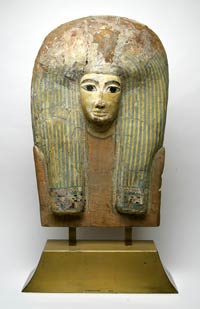 |
Impressive Female Coffin Portrait. Egypt, Third Intermediate Period, 21st-22nd Dynasty, c. 1085-800 BC. With polychrome-painted gesso over wood, the woman with huge blue and yellow lappet wig, the ends tied by colorful "jeweled bands." Her delicate features rendered in yellow, with black for the eyes, and blue for the brows. Few traces remain of the woman's shawl and beaded collar that would have covered her chest. Piece mounted in an expensive, custom display which could be hung, or set on a table. Height of object: 22-1/4". Case: 31-3/4" x 19-3/4" x 9-1/2". A large and very eye-catching antiquity!
Estimated Value $8,000 - 9,000.
View details and enlarged photo
| Unsold |
Lot 1242 |
|
Withdrawn
| Unsold |
Lot 1243 |
 |
Finely Inscribed Fragment of an Osiris Statue, in Brown Basalt. Egypt, 26th-30th Dynasties, c. 664-341 BC. Torso fragment from a superb enthroned Osiris, the god in shroud-like garment with beaded collar, with hands before his heart and holding flail and crook. The back of his throne with single register of hieroglyphs, very handsomely engraved. Aside from the obvious losses pictured, stone work in excellent condition. Height: 4".
Estimated Value $2,000 - 2,500.
Cf. Scott, Harer Collection, no. 24.
View details and enlarged photo
| Unsold |
Lot 1244 |
 |
A Rare "Corn Mummy" & Falcon Sarcophagus. Egypt, Late Dynastic, 26th-30th Dynasties, c. 664-342 BC. Carved wood anthropoid mummy case, with carefully sculpted falcon's head, gessoed and painted in a more somber coloring. The face gilt, with the bird's facial markings in black, a lappet wig in blue-black with gilt edging, and a beaded broad collar in red. The rest of the figure in black. Within, the "corn" mummy of Osiris with simple wrappings, and covered with bitumen. Underneath the mummy's "head" is a portion of wax sheeting, which comprised the portrait maskette of Osiris. The missing front part of the maskette may have had the god's likeness rendered in gold, and was plundered sometime in the past. This aside, the mummy very well preserved. The wood coffin equally fine, with only a small chip to the tip of the falcon's beak, and another chip to the base of the back section (which may have been touched up). The back pillar to the coffin, and a section of the headdress above it show staining and some paint loss to indicate the coffin was once in contact with a moist surface, or was exposed to leaking fluids. This damage looks ancient. It also reveals that part of the coffin was once painted blue and white.That its color scheme was altered to the specifications of the ancient purchaser is not uncommon. This does not lessen the rarity or qualty of this artifact, but does add a footnote of interest. Height of coffin: 18-1/2". A museum quality display piece that should arouse much interest.
Estimated Value $12,000 - 18,000.
Provenance: Northeast U.S. Private Collection, this among a number of Egyptian antiquities purchased in Cairo in the early 1950's, during the time of the Farouk palace sales, and which were cleared for release by the Cairo museum at that time. Without a doubt, the best comparison to this piece is the nearly identical coffin and corn mummy in the sale of the Harer collection at Christies New York last December 9; lot 25, with the coffin more pristine, and the Osiris maskette intact, there the lot realized $48,000.
Osiris, as the supreme god of resurrection, was inextricably connected by the ancient Egyptians with the life-giving forces of nature and vegetation, particularly as it pertained to the Nile. Above all, he was associated with germinating grain. The emergence of a growing plant from an apparently lifeless seed, hidden within the earth, was regarded by the Egyptians as a metaphor for the rebirth of a human being from the lifeless corpse. This idea was translated into concrete form by the fashioning of images of Osiris out of earth and grain. These "corn-mummies" (more correctly, "grain-mummies") were composed of sand or mud, and mixed with grains of barley. Sometimes these body surrogates were wrapped in linen bandages and might receive a finely detailed mask of wax, often with gold sheet covering, to represent the face of Osiris.
View details and enlarged photo
| Realized
$13,800 |
Lot 1245 |
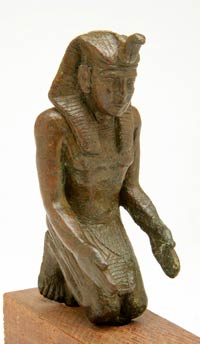 |
Important Bronze of Pharaoh in Offering Pose. Egypt, 26th-30th Dynasties, c. 664-342 BC. Figure in kilt, wearing broad collar, and striped nemes headdress with cobra ornament over forehead. The pharaoh kneels forward, with hands extended in offering position. The image of good size, finely modeled, and preserved; the bronze with red and brown patina and occasional green. There is a tenon under both feet and knees. Height: 4-7/8", not including tenons. An impressive work of art, and a less common motif seen in bronzes.
Estimated Value $25,000 - 30,000.
Cf. Fazzini, Images for Eternity, no. 98. For a recent study of the subject, see Hill, Royal Bronze Statuary from Ancient Egypt, With Special Attention to the Kneeling Pose.
View details and enlarged photo
| Unsold |
Lot 1246 |
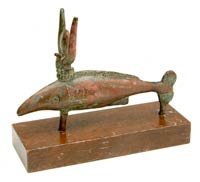 |
Oxyrhyncus Fish, in Bronze. Egypt, Late Period, c. 664-342 BC. The Oxyrhyncus fish has about its neck a broad collar of beads. On its head, a crown of uraei with single large uraeus, topped by the crown of Hathor. The eyes deep sunk, once probably inlaid. The fish stands on two tenons, mounted into an old mahogany base. Item appears to be an old collection piece, with variegated patina of red and deep brown, with areas of green. Some details a bit worn, suggesting the amulet received a good deal of handling in its history. Length: 5-3/8".
Estimated Value $2,000 - 2,200.
View details and enlarged photo
| Unsold |
Lot 1247 |
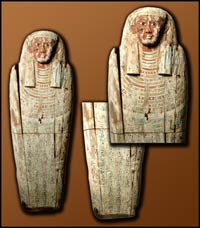 |
Colorful Wooden Cover from a Sarcophagus. Egypt, Late Dynastic - early Ptolemaic, c. 400-250 BC. A nearly complete coffin lid, minus the foot panels, with a handsome portrait of a man, and extensive polychrome and inscriptions. The man's face in red-brown color, wearing a striated tripartite wig, and a broad beaded collar with Horus falcon head terminals. Below the collar, a winged Isis kneels right, above seven registers of hieroglyphs, these flanked on either side by the four Sons of Horus. All details rendered in black, green, red, or blue paint. The lid cut sometime in its past, otherwise essentially "as found", and free of any obvious restorations and enhancements, other than some stabilizing slats screwed to the interior. Height: 65". An impressively large Egyptian wooden artifact, at a very affordable price.
Purchasers please note: this item will be packed and shipped by an art transport service only - - details to be arranged by the buyer and the shipper.
Estimated Value $10,000 - 12,500.
Southern California Collector, acquired in the early 1980's.
View details and enlarged photo
| Realized
$9,200 |
Lot 1248 |
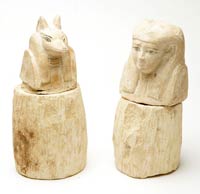 |
Pair of Model Canopic Jars in Limestone. Egypt, Late Dynastic or Ptolemaic, c. 400-200 BC. The jars of short barrel form and rough-carved -- either in the process of being worked, or perhaps in this state where they would have received a finishing coat of stucco or plaster, a trait often seen in sculpture done in Ptolemaic Alexandria. The lids in the form of the jackal-headed Duamutef, and the human-headed Imsety - - both sons of Horus. Both are well carved. Duamutef anchored to his jar, with residues of stucco apparent. That of Imsety unattached, with chipping to the jar. Condition of portraits excellent, with remaining black paint apparent at eyes, brows, and beaded collar on the jackal. Both with faint traces of blue paint on the wigs. Heights: 8-1/2"; 9". Lot of 2 items.
Estimated Value $8,000 - 10,000.
Note Petrie Museum item no. UC29794, a dummy canopic jar of the 20th Dynasty with Duamutef, for similar stubby shape, although somewhat more tapered than those above. It appears that in the Late Period the viscera were sometimes bandaged and returned to the body cavity. Thus a dummy set of canopic jars (which these examples may be) were nevertheless provided to fulfill all the traditional accoutrements of the burial.
View details and enlarged photo
| Unsold |
Lot 1249 |
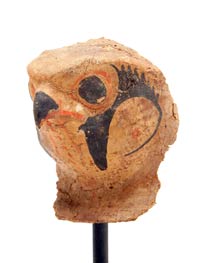 |
A Falcon Head Cartonnage from a Falcon Mummy. Egypt, Late Dynatic-Ptolemaic, c. 400-200 BC. A compelling portrait piece of a different type! The cartonnage maskette of stucco, layered over a shaped linen form, and painted a buff color, with detailing in red and black. Piece in very fine condition, the plaster stable and sound. Height: 2-7/8", on custom base. An attention-getting cabinet piece!
Estimated Value $900 - 1,000.
Cf. Goldberg Auction 35 (April 15, 2006), lot 871, for the type of mummy that would have employed this head piece.
View details and enlarged photo
| Realized
$1,150 |
Lot 1250 |
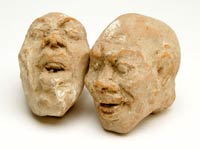 |
Pair of Comedic Grotesques in Terra Cotta. Egypt, Hellenistic or Graeco-Roman Alexandria, c. 2nd-1st century BC. Popular portraits of mimes or comedy actors, with outlandish features, and fearsome grimaces. Both bald with ample teeth displayed. Heads appear to be wholly hand modeled, or at the least, heavily reworked moldings - - the extensive and deeply impressed fingerprints of their makers clearly evident. This is actual Hellenistic era sculpture, rather than a mass produced image. Pieces intact as shown, with minor rubbing or occasional chips to the high spots. Lengths: 2-1/2"; 2-7/8". Lot of 2 items.
Estimated Value $800 - 900.
View details and enlarged photo
| Unsold |
Lot 1251 |
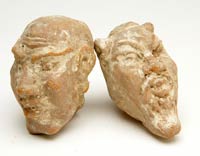 |
Pair of Comedic Grotesques in Terra Cotta. Egypt, Hellenistic or Graeco-Roman Alexandria, c. 2nd-1st century BC. Popular portraits of mimes or comedy actors, with outlandish features. One a devil-like satyr; the other pleasantly befuddled, with more chin than a neck can support. Heads appear to be wholly hand modeled, or at the least, heavily reworked moldings - - the extensive and deeply impressed fingerprints of their makers clearly evident. Pieces intact as shown, with minor rubbing or occasional chips to the high spots. Lengths: 3"; 2-5/8". Lot of 2 items.
Estimated Value $800 - 900.
View details and enlarged photo
| Unsold |
Lot 1252 |
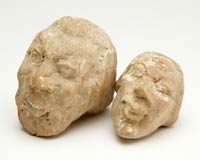 |
Pair of Comedic Grotesques in Terra Cotta. Egypt, Hellenistic or Graeco-Roman Alexandria, c. 2nd-1st century BC. Popular portraits of mimes or comedy actors, with outlandish features. One with long hair and beard; the second almost looks like an old woman - - rather like a long-married couple who have grown alike in appearance. Heads appear to be wholly hand modeled, or at the least, heavily reworked moldings - - the extensive and deeply impressed fingerprints of their makers clearly evident. Pieces intact as shown, with minor rubbing or occasional chips to the high spots. Lengths: 3"; 2-5/8". Lot of 2 items.
Estimated Value $800 - 900.
View details and enlarged photo
| Unsold |
Lot 1253 |
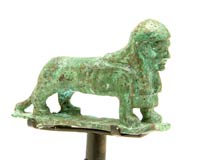 |
Rare Graeco-Roman Sphinx in Bronze. Roman Egypt, c. late 1st century BC. - 2nd century AD. The sphinx stands on stumpy legs, and is shown in the traditional manner with long lapet wig, and the panel of a kilt draped over the front legs. The face is treated in an almost portrait-like manner, the plump features recalling those of Nero or Domitian. The creature on rectangular base, a little eroded at the rear. Otherwise intact and well modeled and preserved, with green patina. Length: 2-5/8", on custom base. Interesting and very rare.
Estimated Value $3,500 - 4,000.
This is the image of the god Tutu (Tithoes, in Greek), whose early appearances in the Egyptian pantheon begin in the later 2nd century BC. He was a popular god in the Ptolemaic period, and more so in the Roman. The god provided protection against demons, and his appearance as a striding sphinx was often combined with symbols of his power, plus visual references to demons and other divinities - - often as an apotropaic aid against diseases. By Roman times his stature increased to where he had become a major god in his own right. His representations are seen most often in reliefs, rather than in-the-round sculptures. Cf. especially Berman, Cleveland, no. 359, a fragmentary miniature sculpture of the god ("… representations of Tutu in the round are rare.").
View details and enlarged photo
| Unsold |
Lot 1254 |
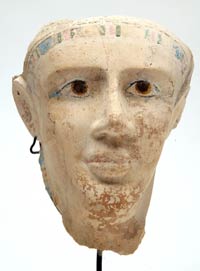 |
A Portrait Head of a Youth, in Painted Stucco, from a Mummy. Roman Egypt, c. 1st-2nd century AD. As in the preceding falcon cartonnage, this too composed of a linen form upon which stucco was layered and painted. The portrait that of a young man, with large brown eyes, outlined in the Egyptian fashion. His headdress with a colored band framing the head, colored in segments of blue green and deep pink, with similar pink at mouth. Mask professionally consolidated and strengthened along the edges on the inside. The face with only minor restoration or paint touch up. Height: 8", on custom stand.
Estimated Value $3,000 - 4,000.
View details and enlarged photo
| Unsold |
Lot 1255 |
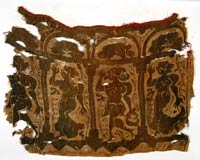 |
Coptic Textile Fragment with Dancing Figures. Coptic Egypt, c. 5th-6th century AD. Interesting woven panel having "Classical" figures within a colonnade. The figures alternate male and female, each in similar dancing pose, with florals and vines bordering each. Condition as illustrated - - there are lacunae, but cloth generally sound, but would be best to be mounted underneath glass. Size: 10-1/2" x 15". A large and visually playful piece, and more interesting than the usual Coptic fare.
Estimated Value $2,000 - 2,200.
View details and enlarged photo
| Unsold |
Lot 1256 |
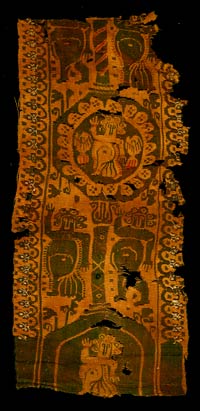 |
Another Coptic Textile Fragment with Dancing Figures. Coptic Egypt, c. 5th-6th century AD. A wide border panel with obvious Bacchic figures both flanking, and centered within medallions. For all the repetition motif, considerable variety has been introduced - - by alternating figure placement, or differing the details to the columns between the figures. Condition as illustrated - - there are lacunae, but cloth generally sound. Again, would be best to be mounted underneath glass. Size: 11-1/2" x 5". A choice Coptic textile, and of good size for display!
Estimated Value $950 - 1,250.
View details and enlarged photo
| Unsold |
Lot 1257 |
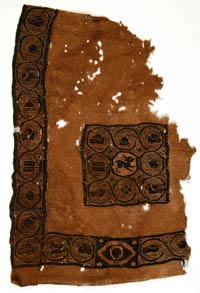 |
Large and Attractive Coptic Textile Fragment. Coptic Egypt, c. 6th-7th century AD. The section comprised of an embroidered square panel close to the l-shaped remains of the border. The appliques in dark brown thread, on a deeply tone plain cloth background. The panel centers a hare, right, within scrolled vines, and having a bird at each corner. The vine and bird motif also carried along the narrow borders, but for one section which appears to contain a large staring eye. Condition as illustrated - - there are some lacunae, but cloth overall sound. Size: 15" x 10-1/2". An unusually large and displayable piece, in better style.
Estimated Value $800 - 1,000.
View details and enlarged photo
| Unsold |
Lot 1258 |
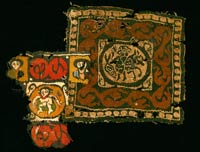 |
Pleasing Lot of Two Coptic Textile Fragments. Coptic Egypt, c. 5th-6th century AD. Lot of two different decorative panels. One with a cute Cupid(?) riding on a hippocamp, in dark brown on buff background, with deep rust floral arabesques around. The second fragment in astonishingly vivid colors, with central nude figure holding thyrsos(?), flanked by red scrolls, with portrait busts in the corners. Condition as illustrated - - there are lacunae, but cloth overall sound. Size of square panel: 6" x 6-1/4". A fun pair. Lot of 2 items.
Estimated Value $750 - 850.
View details and enlarged photo
| Unsold |
Lot 1259 |
 |
Well Preserved Black-Glazed Kylix. Greece, likely Athens, c. 4th century BC. Well potted, robust, stemless kylix with fine black glaze. The bowl rather deep, with turned out rim, deep sunk groove at shoulders, and heavy handles. Intact and virtually pristine, with cleanable dirt. Width: 10-7/16". A sizable decorative object.
Estimated Value $400 - 500.
View details and enlarged photo
| Realized
$575 |
Lot 1260 |
 |
Terra Cotta Votive Head of A Woman. Etruscan, c. 4th-3rd century BC. Facing head and shoulders of woman with pleasant features, and appealing abundant hair, crimped into tight curls. Drapery at her neck, and the format of the molding creates a veil-like frame to her head. Condition overall very fine, with restoration to tip of nose, and the left shoulder/base. Also a small area of infilling on the back. Height: 11-1/4". An attractive and large display piece.
Estimated Value $2,000 - 2,500.
View details and enlarged photo
| Unsold |
Lot 1261 |
|
Sizable Medical Votive Profile Portrait. Etruscan, c. 4th century BC. A high relief "half head" portrait, i.e., the left side only, is molded of a young woman with pleasant features, and softly waved hair covered by a veil. Molded in a granular pinkish clay with vent hole on the back, which also would have facilitated hanging the relief on a wall. Minor chip to chin and collar, otherwise in very fine condition. Height: 9-7/8".
Estimated Value $1,000 - 2,000.
Quite nice workmanship for a votive, and notable for its rather large size. The half of the head depicted would be the body part afflicted, to which the prayers of a temple's priests would be directed.
View details
| Unsold |
Lot 1262 |
|
Withdrawn
| Unsold |
Lot 1263 |
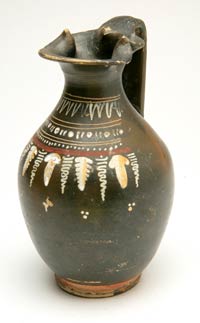 |
Colorful Gnathian Trefoil Oinochoe. Magna Graecia, Apulia, c. 330 BC. Potted from a fine grained buff ware, with black glaze, and applied "Oxford Vine" motif in red, white, and yellow - - three ornamental rows, with grape clusters alternating with vine tendrils at the bottom.Vessel free of repairs, with slight nick to rim, and few minor spots of rubbed glaze. Height: 6-1/2". Nice affordable display piece.
Estimated Value $500 - 600.
View details and enlarged photo
| Realized
$633 |
Lot 1264 |
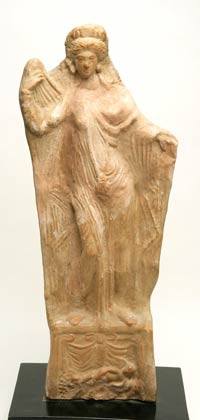 |
Large, Impressive Terra Cotta of Aphrodite/Venus. Graeco-Roman Southern Italy, perhaps Sicily, c. 1st cent. BC. - 1st cent AD. The slim, wide-hipped goddess stands on high plinth, wearing diaphanous garments, and raises with one hand the edge of her garment while the other hand is out to the side - - in a gesture that is both revealing and regal. A long necklace with cockleshell pendant hangs down to her waist. A stephane crowns her head. The plinth with scene of Eros/Cupid sleeping beneath a cloth partition. A huge moldmade terra cotta, with vent hole at back. Repaired, with area of restoration mostly to back and left shoulder of Venus. Height: 23", on custom base. Rare in this size and preservation.
Estimated Value $5,000 - 6,000.
Formerly in a west German private collection. Previously with Superior Galleries in the 1990's.
View details and enlarged photo
| Unsold |
Lot 1265 |
 |
Attractive Maskette in Bronze. Roman, circa A.D. 1st-2nd Centuries. Base of handle from a bronze jug. The handle with leaf motif; and below, facing head of youthful satyr. His features are round and pleasant, with animal ears visible at sides. Length: 3-9/16". In exceptional condition with excellent modeling and an even dark patina.
Estimated Value $150 - 250.
Ex Superior Auction (6-2/3-98), lot 6117. Said to have been found in Bulgaria.
View details and enlarged photo
| Realized
$86 |
Lot 1266 |
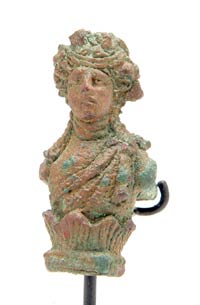 |
A Bronze Fitting with a Delightful Bust of a Youthful Dionysus. Rome, c. 1st-2nd century AD. This a finely detailed miniature to those usually seen - - perhaps forming part of a delicate tripod or small decorative table. The bust emerges from a floral base with a horizontal bar at his back. The god with a patterned animal skin over shoulder, and a wreath of leaves and fruit coursing through his long hair. The god's portrait with an almost blasé air of a world wise sophisticate. Sharp, with reddish brown and green patina. Height: 2-3/8", on custom stand.
Estimated Value $850 - 1,250.
View details and enlarged photo
| Unsold |
Lot 1267 |
 |
Amusing Bear Figurine in Bronze. Gallo-Roman or Roman Britain, c. 2nd-3rd century AD. Charming genre study: animal seated, head cocked to one side, and one paw atop a floral scroll. The body simply rendered, with expressive modeling to the head. Base chipped. Overall in fine condition, with brown to olive-gray patina. Height: 1-7/8"; on lucite stand. Delightful study. Bears are a popular, yet less common subject.
Estimated Value $200 - 300.
View details and enlarged photo
| Realized
$115 |
Lot 1268 |
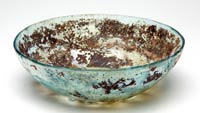 |
Early Roman Bowl in Light Aqua Glass. Roman, 1st century AD. This simple bowl is fairly shallow, and cast rather than blown. The exterior shows "fire polish" while the rim and interior finished with lapidary techniques. Intact and nicely preserved, this piece with areas of black crusty patina, plus zones of soft creme-rose iridescence, along with more transparent and vivid touches of green, violet, and rose. Diameter: 5-3/8".
Estimated Value $750 - 950.
View details and enlarged photo
| Unsold |
Lot 1269 |
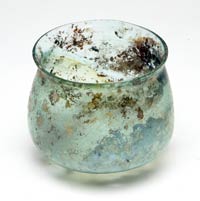 |
Iridescent Beaker or Jar. Roman, c. 1st to 2nd century AD. Robust and with some heft, the cup in light green glass, with flaring rim and sharply conical body set on angled convex bottom. On the outside, paired decorative grooves have been lightly engraved and encircle the lower part of body, with a third just under the rim. Cup is intact and perfect. Mixed with areas of blackish patina is iridescence which is transparent to sparkling, mainly in silver, cremes, and rose. Height: 2-1/2". A stylish shape.
Estimated Value $450 - 650.
Cf. G.A.E. Vol. 1, pl. 65q; Hans Cohn Collection, fig. 120.
View details and enlarged photo
| Unsold |
Lot 1270 |
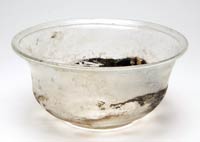 |
Neatly Crafted Footed Bowl. Roman, c. 2nd-3rd century AD. Bowl in clear glass, with rounded bottom and then straight flaring walls, all on mold blown foot. Bowl's rim neatly folded over and rounded. Intact and pristine, with some cleanable dirt and trivial deposits. Diameter: 6-1/4". Surprisingly symmetrical for these often erratically shaped pieces - - this a robust, choice example.
Estimated Value $1,000 - 1,500.
View details and enlarged photo
| Unsold |
Lot 1271 |
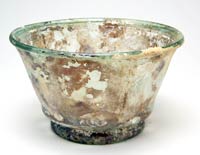 |
Large and Substantial Footed Bowl. Roman, c. 2nd-4th century AD. Blown from a light leaf green glass, the bowl with almost cylindrical bottom then straight flaring sides, all on folded flaring foot. The bowl's mouth everted, with rim folded inward. Intact and perfect. Bowl with some cleanable dirt and a bit of sea encrustations, along with areas of colorful green, magenta, and violet iridescence. Diameter: 7". Piece robust and solid. Diameter: 6-1/4". A choice example of good size.
Estimated Value $1,350 - 1,650.
View details and enlarged photo
| Unsold |
Lot 1272 |
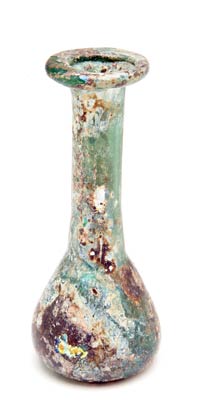 |
A Substantial Balsamarium with Peacock Iridescence. Roman, 1st-2nd century AD. Blown in a thick medium-deep green glass, the bottle with small piriform body, cylindrical neck, and disc-like rim. The exterior with variegated patina-iridescence, with color patches of peacock brilliance - - in coppers, cobalt, and brilliant greens. Height: 4-3/8". Very nice.
Estimated Value $225 - 325.
View details and enlarged photo
| Unsold |
Lot 1273 |
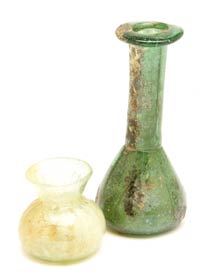 |
Substantial Balsamarium with Flashy Iridescence. Roman, 1st-4th century AD. Blown from a thick deep green glass, the bottle like the preceding lot. Exterior with variegated patina, with hints of iridescence. Also, a small funnel mouth bottle in pale green glass, with ovoid body, and dimples and vertical ridges at neck. Both pieces pristine. Largest height: 4-5/8". Good lot. Lot of 2 items.
Estimated Value $300 - 450.
View details and enlarged photo
| Realized
$180 |
Lot 1274 |
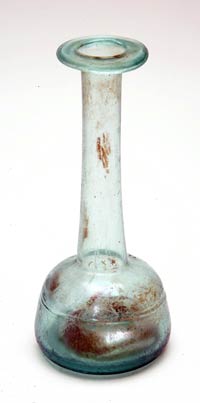 |
Large, Solid Unguentarium with Stylish Bell-shaped Body. Roman, 1st to 2nd century AD. A very substantial bottle in light green glass. Its mouth with rolled rim, and a narrow neck, and rounded lower body that is nearly conical, with tooled encircling groove. Intact and perfect. With thin, transparent iridescence in quite appealing bright greens, magentas, and copper hues. Well proportioned and symmetrical. Height: 8". A fine example of this class.
Estimated Value $500 - 600.
View details and enlarged photo
| Realized
$575 |
Lot 1275 |
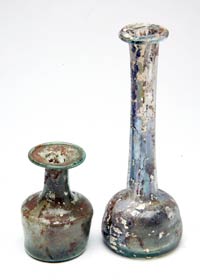 |
Two Attractively Shaped Bottles. Roman, 1st to 2nd century AD. The largest, very substantial, and a smaller replica to one already seen in a previous lot, but this bottle in clear glass. With thin to silvery transparent iridescence, with appealing greens, magentas, and violet hues. The second of much the same shape, but with distinctive inward tapering body. This in green glass, with strongly concave base. Intact and pristine. Heights: 5-3/4"; 2-3/4". Both well proportioned and having good eye appeal. Lot of 2 items.
Estimated Value $450 - 650.
View details and enlarged photo
| Unsold |
Lot 1276 |
 |
Long Necked "Candlestick" Unguentarium. Roman Syria, 2nd Century AD. Blown from a clear to faintly aqua glass, flask with flat everted mouth, slightly flaring cylindrical neck, and flattened, conical/bell body. Glass with some blackish deposits, and touches of thin transparent iridescence. Intact and perfect. Height: 6".
Estimated Value $350 - 450.
Cf. Harden Pl. XX Fig. 799. Newark Fig. 138.
View details and enlarged photo
| Realized
$460 |
Lot 1277 |
|
A Pair of Colorful Small Bottles. Roman, c. 2nd-4th century AD. One resembling a "pilgrim's flask," in light green glass, with a globular body which was flattened. The later bottle in pale yellow, mold blown, with broad ovoid body and spiraling ribs up the neck and mouth. Both with some repairs; with the squat bottle showing moderate restoration on one side. Both pieces iridescent; the flask tending to silvers and violets, while the bottle resplendent in luscious limes and oranges, accented with cool greens and blue greens. Heights: 4-1/4"; 2-5/8". A pair of flashy cabinet pieces.
Estimated Value $350 - 650.
View details
| Unsold |
Lot 1278 |
|
Sizable and Solid Cosmetic Flask. Roman, 3rd-4th century AD. A substantial piece, in thick green glass. The vase, blown with funnel mouth and thick rim, also featuring a long cylindrical neck that flares out into a small piriform body, with spiraling ribbing at bottom. The piece sits on a broad, folded, flaring foot. Twin v-shaped handles have been applied to the rim in deeper green, with "thumb rests" at top. Fine iridescence in soft cremes and violets, with additional flashy metallic greens, and blues hide beneath cleanable earthen and black patina. Intact and attractive. Height: 5-1/4".
Estimated Value $750 - 950.
View details
| Realized
$1,035 |
Lot 1279 |
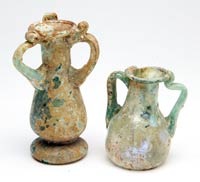 |
A Pair of Multi-handled Iridescent Bottles. Roman Syria, 3rd to 4th century AD. Both in green glass, and of similar forms, but one footed. The largest of substantial construction, plus having three v-shaped handles applied. More unusual and rare is that this is actually a dropper flask, with a diaphragm set into the neck. The smaller much the same, but in normal thinner glass, with twin handles and no foot. Both intact. The smaller with patches of vivid green and violet iridescence; these more muted on the larger. Heights: 2-1/4".; 3-1/4". Lot of 2 items.
Estimated Value $800 - 900.
View details and enlarged photo
| Realized
$978 |
Lot 1280 |
|
Monumental Flask with Stunning Iridescence. Roman, 4th-5th century AD. Blown in a medium light green glass, with broad, rounded piriform body, columnar neck with wide folded flange near rim. The ample surfaces are the perfect display for the outstanding iridescence - - from subtle translucent to transparent creme-silvery to flashy mottled greens, purples, and wonderful copper-rose-oranges. Intact and perfect! Height: 11-1/2". Extraordinary preservation for glass this size, coupled with its entrancing coloring, makes this a rare treasure indeed!
Estimated Value $3,000 - 4,000.
View details
| Realized
$4,715 |
Lot 1281 |
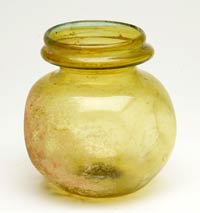 |
Colorful Jar with Indented Walls. Roman Syria, c. 4th to 5th century AD. Jar blown in boldly yellow glass, with wide mouth and slightly curved rim, with folded collar beneath. The neck broad, and the body globular. The body walls indented in five places, giving the jar an unusual pentagonal shape. Jar intact and pristine, with a little bit of cleanable dirt. Height: 3-1/2". A flashy-looking bottle.
Estimated Value $450 - 550.
View details and enlarged photo
| Unsold |
|
|